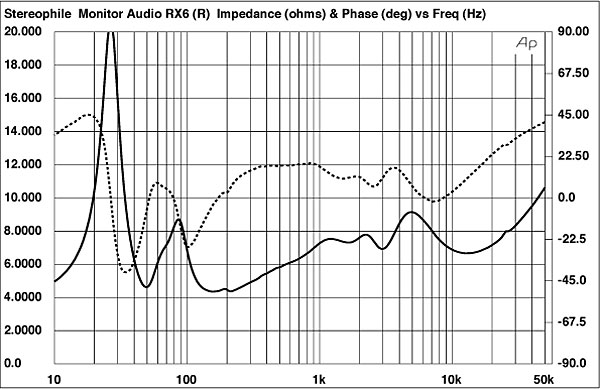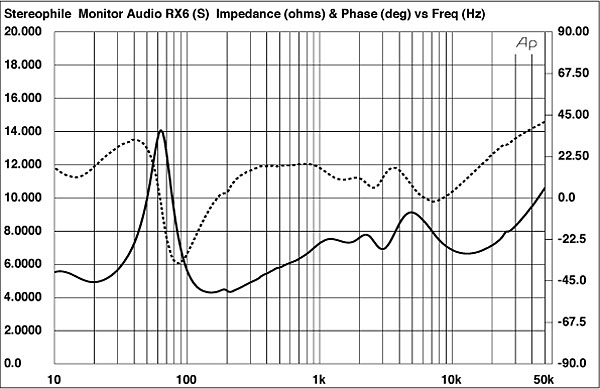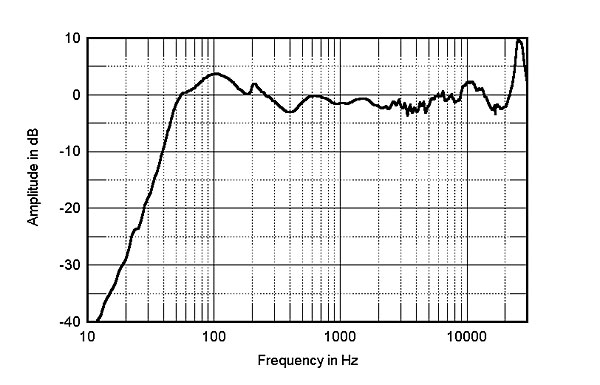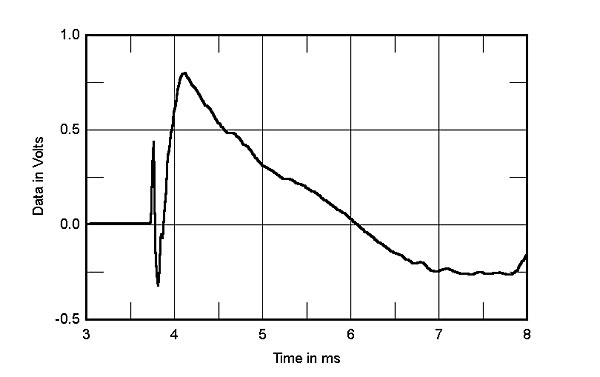| Columns Retired Columns & Blogs |
What Dac, amp, and other equipment would you recommend with these speakers? Thx!
I used DRA Labs' MLSSA system and a calibrated DPA 4006 microphone to measure the Monitor Audio Silver RX6's frequency response in the farfield, and an Earthworks QTC-40 for the nearfield responses. The Silver RX6 is specified as having a voltage sensitivity of 90dB/W/m. My estimate was slightly lower, at 88dB(B)/2.83V/m, which will not be a problem. The RX6's impedance (fig.1) remained below 8 ohms over most of the audioband, with a minimum magnitude of 4.35 ohms at 160Hz; this speaker will work best with 4 ohm–rated amplifiers and receivers. Fig.1 was taken with both ports open. Closing the ports with the supplied foam bungs gave the impedance shown in fig.2; the speaker now behaves as a sealed-box design with a tuning frequency of 66Hz, which will help with optimizing the sound on boomy rooms, but there is no difference in the impedance above 100Hz.


The small discontinuity at 25kHz in the impedance traces indicates that this is the frequency of the metal-dome tweeter's "oil-can" resonance. This is safely above the audible range. The unusual peak at 200Hz in the impedance-magnitude traces implies the presence of some sort of resonance at this frequency. However, while investigating the cabinet panels' vibrational behavior with a plastic-tape accelerometer did reveal a minor mode at 200Hz, there was also a family of panel resonances higher in frequency, at 379, 430, 516, and 656Hz (fig.3). This graph was taken with the accelerometer on the side panel level with the midrange drive-unit; the same resonances were evident, but at different levels, at other places on the side panel, as well as on the top of the enclosure. I would have expected these resonances to result in some sense of midrange congestion, but it is fair to note that BJR didn't comment on lack of clarity in this region. This measured behavior might look worse than it sounds, due to the high Quality Factor (Q) of the resonances.

Though there is a midbass saddle in the reflex-impedance trace (fig.1), this doesn't represent the tuning frequency of either port, as each behaves somewhat differently. The rear port loads the midrange unit; its nearfield response, shown as the green trace in fig.4, peaks broadly between 40 and 120Hz. It is tuned to 63Hz, as revealed by the minimum-motion notch in the midrange unit's output (fig.4, black trace). The corresponding notch in the woofer's output (fig.4, blue trace) is significantly lower in frequency, at 46Hz, and the output of the front port, which loads the woofer, also peaks lower in frequency than the rear port, between 35 and 75Hz. However, you can see in this graph a major peak at 200Hz in the front port's output, which coincides with both the small impedance peak in figs. 1 and 2, and a small suckout in the woofer's nearfield response. Again, I would have expected this behavior to have audible consequences, and again it is fair to note that BJR heard nothing amiss in the upper bass.

This port behavior can be seen to the left of fig.5, which shows the complex sum of the Silver RX6's nearfield responses, taking into account acoustic phase and the different distance of each radiator from a nominal farfield microphone position. However, as with the earlier RS6, which used a similar arrangement—see my measurements—the unusual combination of reflex-loaded midrange and bass drivers results in excellent low-frequency extension for what is really quite a small tower speaker. The response is down 6dB just above 40Hz, which coincides with the lowest note of the four-string double bass or bass guitar. All things being equal, the fact there are two drivers covering much the same low-frequency range will reduce distortion in this region. The rise in output in the upper bass in fig.5 is mostly due to the nearfield measurement technique.

To the right of fig.5, the RX6's farfield response on the tweeter axis, averaged across a 30° horizontal window, is remarkably even. The peak at 25.5kHz is the tweeter's fundamental dome resonance. While there is the suggestion of a slight trough in the mid-treble in fig.5, the Monitor Audio's plot of lateral dispersion (fig.6) reveals a small degree of off-axis flare in the same region. In a room of small to medium size, this will be balanced by the on-axis trough to give a neutral tonal balance throughout the treble. As usual, the tweeter becomes increasingly directional with frequency in its top octaves, which might make the speaker sound a little lacking in air in large rooms. In the vertical plane (fig.7), a suckout in the upper crossover region develops more than 10° above the tweeter axis, which is itself a quite low 34" from the floor with the speaker sitting on its spiked bases. Don't judge the sound of this speaker unless you are sitting down.


The RX6's step response on the tweeter axis (fig.8) reveals that all three drive-units are connected with positive acoustic polarity. The decay of the tweeter's step blends smoothly with the start of the midrange unit's, indicating optimal crossover design. The cumulative spectral-decay plot on the tweeter axis (fig.9) is astonishingly clean, with just a low-level, high-Q resonant mode evident at 6.4kHz. This is probably the first breakup mode of the midrange unit's cone, and is well suppressed by the crossover.


That 200Hz mode in the front port's output aside, Monitor Audio's Silver RX6 offers superb measured performance, supporting BJR's high opinion of its sound quality, at a very affordable price.—John Atkinson

What Dac, amp, and other equipment would you recommend with these speakers? Thx!